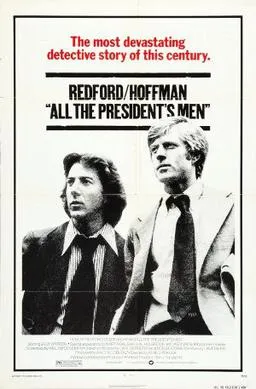Historical accuracy of All the President’s Men

Historical accuracy of All the President’s Men

Characters
Bob Woodward (Robert Redford)
Accurately portrayed as one of the lead reporters breaking the story. Some note the portrayal is less shy than reality, and Redford's appearance differs from Woodward's.
Carl Bernstein (Dustin Hoffman)
Accurately portrayed as Woodward's partner in the investigation, known for his writing skill and persistence, though the film may downplay real-life partnership friction.
Ben Bradlee (Jason Robards)
Widely praised, Oscar-winning portrayal accurately captures Bradlee's tough journalistic standards and crucial support for his reporters against pressure.
Deep Throat (Hal Holbrook)
Accurately depicts Woodward's secret source (later revealed as FBI's Mark Felt) meeting in shadows, providing cryptic guidance and confirmation, consistent with accounts.
Harry Rosenfeld (Jack Warden)
Accurately portrayed as a key editor managing the story and the reporters.
Howard Simons (Martin Balsam)
Generally accurate portrayal, though some real Post staffers felt the film made him seem slightly more confused or less central than he was.
More characters
Hugh Sloan Jr. (Stephen Collins)
Accurately shown as a key early source providing crucial information about the handling of CREEP funds, despite personal risk.
Bookkeeper (Jane Alexander)
Based on the real bookkeeper Judy Hoback Miller, accurately portrayed as reluctantly confirming financial details to Bernstein.
Donald Segretti (Robert Walden)
Accurately represents the real Segretti and the nature of the political sabotage campaign linked to the Nixon re-election effort.
James W. McCord Jr.
Accurately depicted in the context of the break-in and his connection to CREEP's security operations.
Frank Wills
Portrayed by himself in the film's opening recreation of his discovery at the Watergate complex.
Story
Watergate Hotel DNC break-in (June 1972)
The film accurately opens with the discovery of the break-in that initiated the scandal.
Initial assignment of Woodward & Bernstein
Accurately shows the Post assigning two relatively junior metro reporters to cover what initially seemed like a minor burglary.
Following the money trail
The painstaking process of tracing funds from the burglars back to CREEP through sources like Dahlberg and Sloan is depicted accurately based on the reporters' book.
Clandestine meetings with Deep Throat
The film accurately portrays the methods (parking garage meetings, signals) and the nature (confirmation, guidance) of Woodward's interactions with his crucial source.
Use of journalistic verification methods
The reporters' reliance on confirming details with multiple sources, checking records (like library logs), and persistent interviewing is accurately shown.
Difficulty getting sources on the record
The film effectively portrays the fear and reluctance of many individuals (like Sloan, the bookkeeper) to speak openly or be named.
White House / CREEP denials and pushback
The official denials, stonewalling, and pressure faced by the reporters and the Post are accurately depicted.
Reporting error regarding Haldeman
The film includes the significant incident where the reporters misinterpreted Sloan and wrongly implicated Haldeman, showing the high stakes and need for precision.
Focus on Washington Post investigation
The film accurately reflects the scope of Woodward and Bernstein's book but consequently minimizes the contributions of other journalists or parallel investigations.
Timeline covered (June '72 - Jan '73)
The film accurately focuses on the first seven months of the investigation, ending around Nixon's second inauguration, as detailed in the first book.
Ending with teletype summary of later events
Accurately reflects that the reporters' initial investigation (covered by the film) preceded the major public revelations, trials, and Nixon's resignation.
Intense work environment and pressure
The film effectively conveys the long hours, stress, and pressure involved in the high-stakes investigative reporting process.
Setting
Washington Post Newsroom recreation
The newsroom set was meticulously recreated on a soundstage based on detailed measurements, photos, and even trash shipped from the actual Post offices.
1970s Office Technology
The use of typewriters, rotary phones, large reel-to-reel tape recorders, and pneumatic tubes accurately reflects the technology used in newsrooms of that era.
Washington D.C. locations usage
The film makes excellent use of authentic DC locations, including the Watergate complex itself, the Library of Congress, and various street views, enhancing realism.
Atmosphere of early 1970s Washington
The film effectively captures the political tension, fashion, and overall visual style of Washington D.C. during the Nixon administration.
Newsroom lighting (fluorescent)
Cinematographer Gordon Willis intentionally used fluorescent lighting to accurately replicate the look and feel of the real Washington Post newsroom.
Deep Throat's parking garage location
While the atmosphere was recreated, the iconic parking garage scenes were filmed in Century City, Los Angeles, not in the actual Rosslyn, Virginia garage used.
Library of Congress Main Reading Room
The visually stunning overhead shot in the Library of Congress Main Reading Room accurately uses the real location for dramatic effect.
